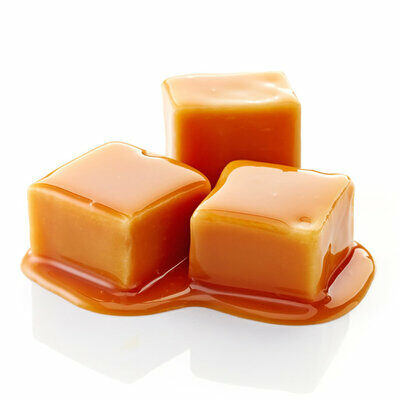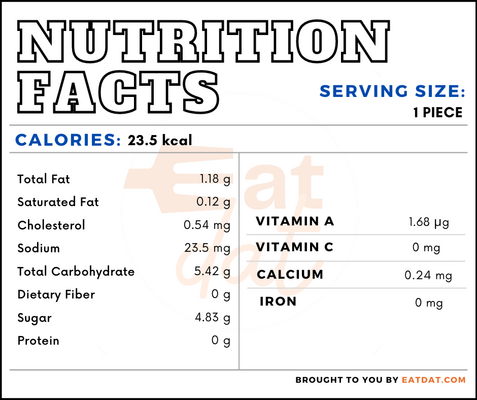
Butterscotch
What is Butterscotch?
Butterscotch is a type of confectionary made from brown sugar and butter. Similar to caramel and toffee, butterscotch is used to flavor desserts, drinks, baked goods, and sweet sauces.
- The ingredients are boiled together until they reach the soft crack stage and take on a signature caramel color.
- The basic version contains only brown sugar and butter, but butterscotch may also contain treacle, molasses, vanilla, salt, and other ingredients for added flavor.
The top 9 most popular butterscotch candy brands are:
- Brach’s
- Sunrise Confections
- Cavendish & Harvey
- Sarah’s Candy Factory
- Atkinson’s Candy
- A Great Surprise
- Quality Candy Company
- Old Fashioned Candy Sticks
- Snackadilly
Origin of butterscotch
The origin of this confectionary is unclear. However, it is probable that it developed from an Arabic sweet in the 1st century AD, known as kurat al milh. The name butterscotch was coined in 1817 in Doncaster, England, by Samuel Parkinson who made confectionaries. The “scotch” part of the name may refer to either the process of scorching the sugar and the butter, or it may refer to the prevalence of this sweet in Scotland.
Nutrition
Nutritional profile for butterscotch (1 piece):

Butterscotch is mainly made of sugar and butter. Sugar can be good for the health of the brain, provided it is consumed in balanced quantities. The brain requires up to 400 calories of glucose per day to function. Consumption of table sugar must be limited to 30 grams per day. However, overconsumption of sugar can lead to an increase in the risk of heart diseases, diabetes, cancer, and other diseases. In addition, it can lead to obesity, depression, and aging.
Butter is high in saturated fats as well as omega 3 and omega 6 fatty acids. Also, it contains decent levels of proteins. There are no or miniscule amounts of carbohydrates present in butter. Butter is a rich source of vitamins A, D, E, and K. It also contains B vitamins such as thiamin, riboflavin, folate, B12, pantothenic acid, and betaine. Additionally, butter is a rich source of minerals like calcium, magnesium, phosphorus, potassium, sodium, zinc, selenium, and fluoride. Despite having a bad reputation, studies have shown that butter does not impact cardiovascular health negatively. Limited consumption of butter may be good for health in the long run.
Commercial production
The commercial production of butterscotch candy begins with boiling sugar and water until they reach soft-crack stage. At this point, other flavoring agents such as salt or vanilla may be added, as well as the butter. After that, the mixture is stirred until the hard-crack stage is reached. Then, the mixture is poured into a butter-coated tray and set to cool. Once set, it is then cut into pieces and allowed to completely cool before serving.
Butterscotch recipes
This is used as a flavoring in desserts, candies, cookies, toppings or frostings, sauces, and beverages. It may also be used in preparing alcoholic drinks, cocktails, and liqueurs. Here are a few recipes:
- Blondies
- Pudding
- Cookie Bars
- Cake
- Ice Cream
- Peanut Butter Bars
- Butterscotch Pecan Dessert
- Salted Butterscotch Bars
- Chocolate Butterscotch Saltine Toffee
- Fudge
- Crunch Squares
- Salted White Russian
- Buttery Nipple
- Butterscotch Milkshake Cocktail
- Harry Potter Butterbeer
- Butterscotch Bliss
FDA regulations
There is no specific standard of identity for butterscotch. However, caramel, which is similar to this candy in both ingredients and cooking method, falls under the generally recognized as safe category and is defined as the dark-brown liquid or solid material resulting from the carefully controlled heat treatment of food-grade sugar.
References
Mahato, Dipendra Kumar et al. “Sugar Reduction in Dairy Food: An Overview with Flavoured Milk as an Example.” Foods (Basel, Switzerland) vol. 9,10 1400. 2 Oct. 2020, doi:10.3390/foods9101400, https://www.ncbi.nlm.nih.gov/pmc/articles/PMC7600122/
Saraiva, Ariana et al. “Natural Sweeteners: The Relevance of Food Naturalness for Consumers, Food Security Aspects, Sustainability and Health Impacts.” International journal of environmental research and public health vol. 17,17 6285. 28 Aug. 2020, doi:10.3390/ijerph17176285, https://www.ncbi.nlm.nih.gov/pmc/articles/PMC7504156/
Pimpin, Laura et al. “Is Butter Back? A Systematic Review and Meta-Analysis of Butter Consumption and Risk of Cardiovascular Disease, Diabetes, and Total Mortality.” PloS one vol. 11,6 e0158118. 29 Jun. 2016, doi:10.1371/journal.pone.0158118, https://www.ncbi.nlm.nih.gov/pmc/articles/PMC4927102/
